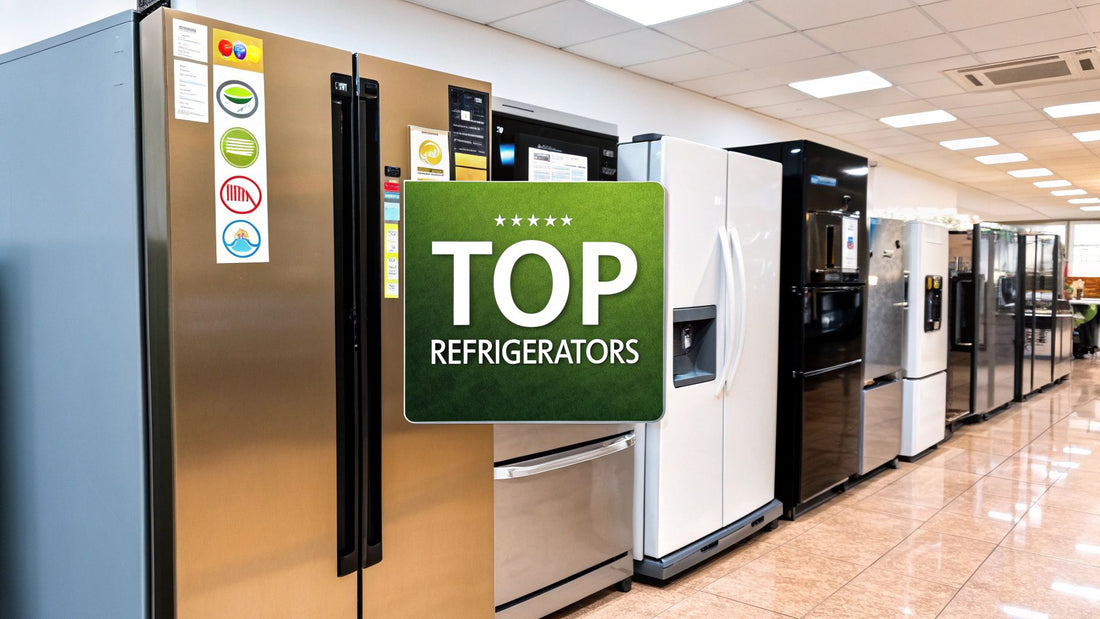
Shop Top Commercial Refrigerator for Sale – Best Deals Available
Share
When you're in the market for a commercial refrigerator for sale, you're making a massive decision for your business. It's not just another piece of equipment; it's a critical investment that directly impacts your food safety, your daily workflow, and even your bottom line. The right unit depends entirely on what your kitchen truly needs.
This guide is here to cut through the noise and show you what actually matters.
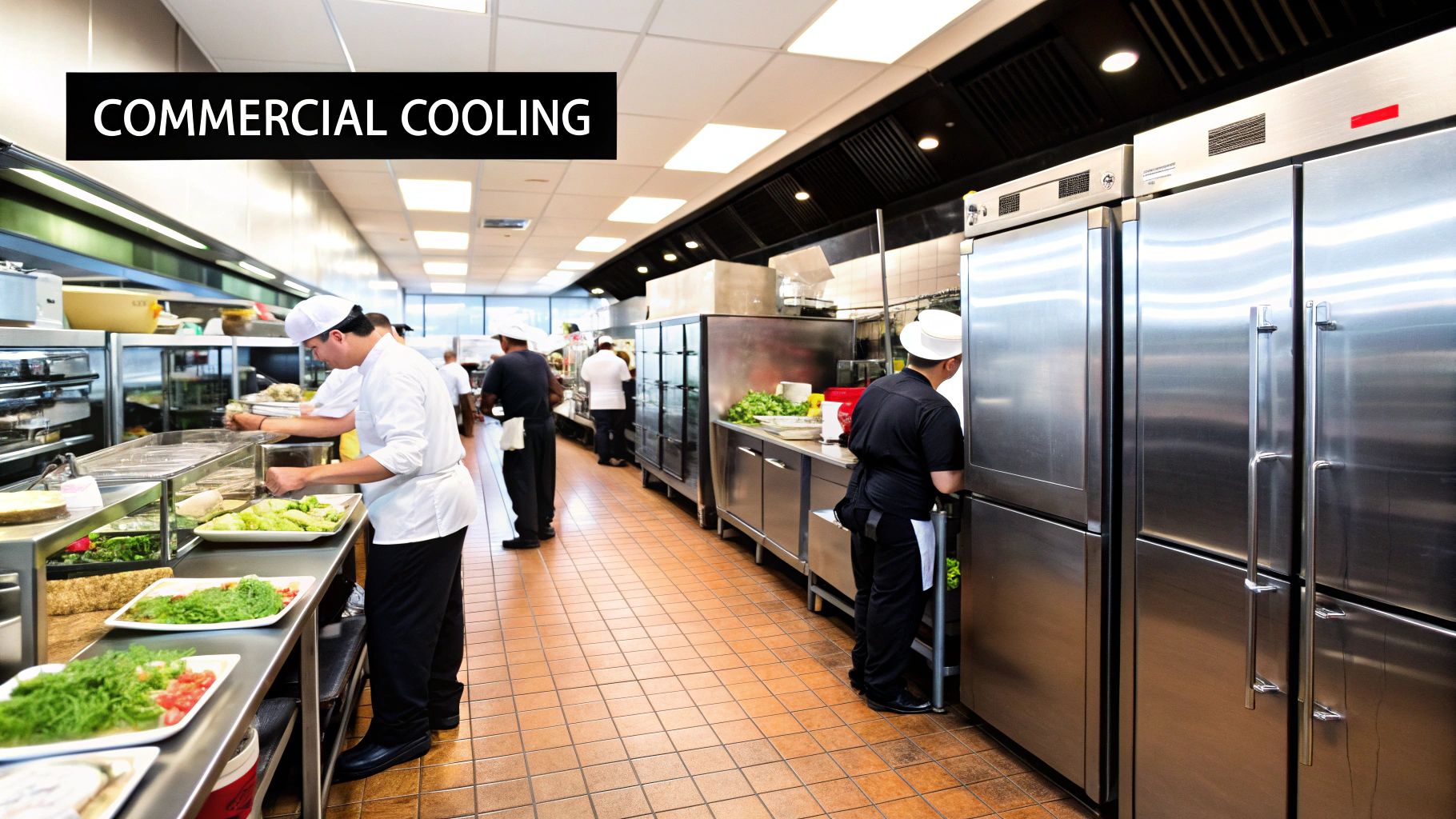
Your Guide to Buying a Commercial Refrigerator
Picking out a commercial refrigerator is way more than just finding one that fits in an empty spot in your kitchen. It’s a strategic choice. A solid, efficient unit protects thousands of dollars in food inventory, keeps the health inspector happy, and helps your team operate without a hitch.
Think of it as the heart of your kitchen. When it's running smoothly, everything else just falls into place. This article is your roadmap to finding that perfect unit. We’ll start with the basic types and then get into the technical specs that make all the difference.
What to Expect in This Guide
Our goal is simple: to make this whole buying process less confusing. We’re breaking it down into easy-to-digest pieces and offering practical advice that will help you land a refrigerator that serves your business well for years.
Here's a quick look at what we'll cover:
- Different Refrigerator Types: We’ll explore the whole range, from standard reach-in coolers to highly specialized prep tables.
- Technical Specifications: You'll get the scoop on compressors, capacity, and what those energy ratings really mean.
- Certifications and Sizing: We’ll explain why NSF ratings are a must-have and how to size your unit correctly.
- Maintenance Best Practices: Learn the simple tricks to protect your investment and keep it running like new.
A well-chosen commercial refrigerator isn't just an appliance; it's a cornerstone of a safe, efficient, and profitable kitchen. It ensures ingredient integrity from delivery to plate, safeguarding both your customers and your reputation.
Diving into all the options can feel overwhelming, but the first step is just getting a handle on the core differences. For a closer look at the various models out there, check out our complete guide to commercial refrigerators. It’s a great resource to build your foundation before we dig into more specialized gear. Arming yourself with a little knowledge upfront will ensure you make a purchase that truly fits your kitchen's demands.
Navigating The Different Types Of Commercial Refrigerators
When you start looking for a commercial refrigerator for sale, you’ll find out pretty quickly it’s not a one-size-fits-all game. The market is packed with specialized units built for specific tasks, kitchen layouts, and business models. Picking the right one is like choosing the perfect tool for a job—get it right, and your workflow is smooth; get it wrong, and it's a constant headache.
Understanding the main categories is your first step toward making a smart investment. Your choice will affect everything from how your staff grabs ingredients to how you display products for customers. The real goal is to find a refrigerator that slots perfectly into your daily operations.
Commercial Refrigerator Types at a Glance
To get a quick lay of the land, this table breaks down the most common types of commercial refrigerators. It's a simple way to see which unit might be the best fit for your business before we dive into the details.
| Refrigerator Type | Primary Use Case | Common Location | Key Advantage |
|---|---|---|---|
| Reach-In Refrigerator/Freezer | Daily ingredient storage | Kitchen prep line | Versatility and easy access |
| Walk-In Cooler/Freezer | Bulk inventory storage | Back-of-house, storage area | Massive capacity for high volume |
| Undercounter Refrigerator | Point-of-use ingredient storage | Under prep tables, service stations | Space-saving efficiency |
| Bar Refrigerator | Beverage storage & display | Front-of-house, bar area | Merchandising and accessibility |
| Glass Door Merchandiser | Grab-and-go product sales | Customer-facing areas, checkout | Drives impulse purchases |
Each of these has a role to play, and the best kitchens often use a combination of several types to keep things running smoothly.
The Workhorses: Reach-In Refrigerators and Freezers
If you had to pick one classic piece of kitchen equipment, it would be the reach-in refrigerator. Think of it as the trusty sedan of the commercial kitchen—it’s reliable, versatile, and you see them everywhere. These are the upright units with one, two, or even three doors that staff "reach into" for ingredients. They are truly the backbone of most kitchen storage plans.
Their main job is simple: keep frequently used items at a safe temperature and within arm's reach for your cooks. You'll find them lining the prep areas and cook lines in restaurants, cafes, and hospitals. Because they're so common, you can find a commercial refrigerator for sale in this style to fit just about any space or budget.
A few key features to look out for:
- Door Configuration: Solid doors are champs at insulation and energy efficiency. Glass doors, on the other hand, let you see what's inside without opening the door and letting cold air rush out.
- Compressor Location: Top-mount compressors are great for cooler kitchens without much dust. Bottom-mount units are generally easier to clean and service, and the lower shelf is easier to access.
- Size and Capacity: They come in all shapes and sizes, from compact single-door models to massive three-door units built for the busiest operations.
This image really helps break down how to think about capacity for any type of unit.
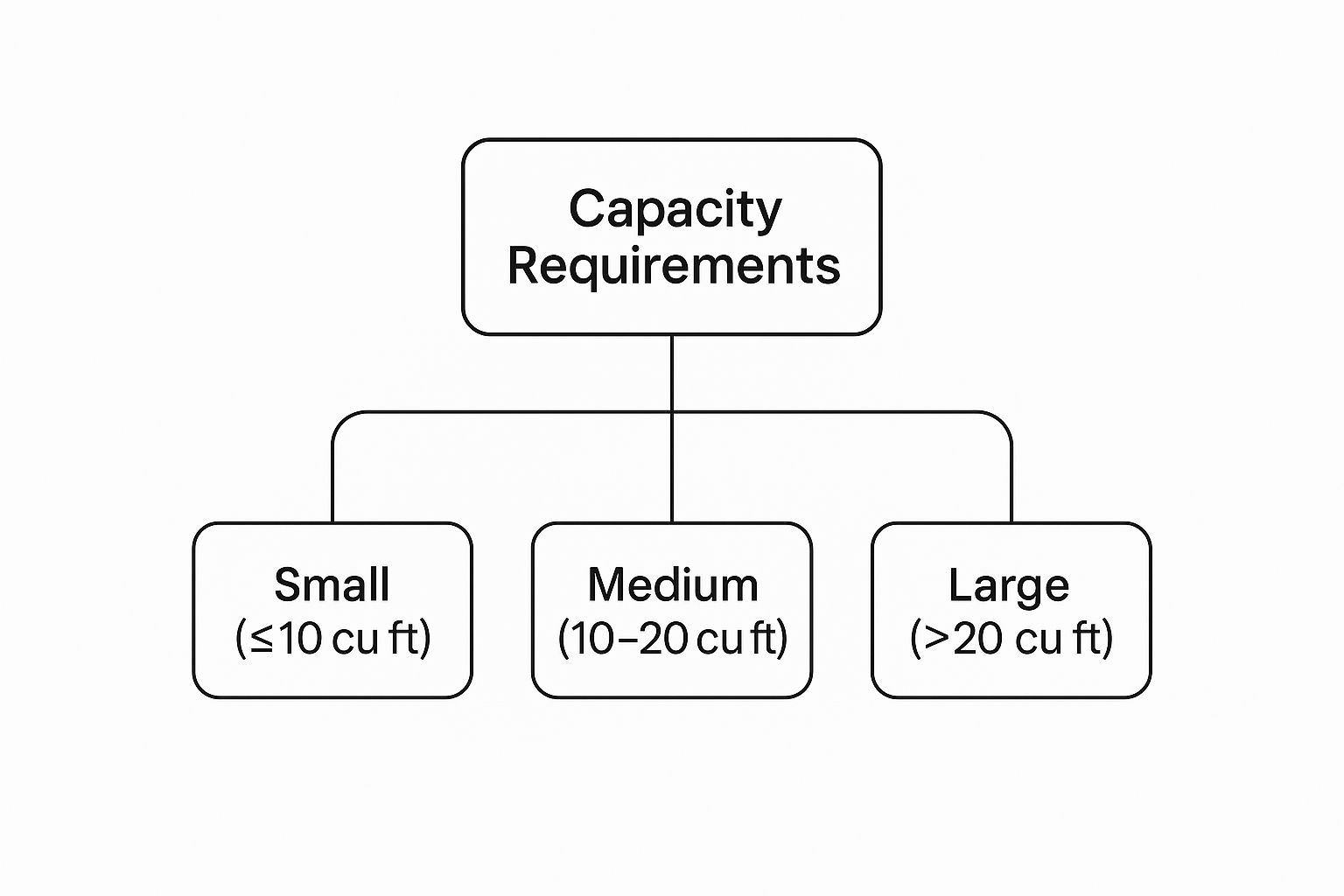
Visualizing your needs this way can help you zero in on whether a small, single-purpose cooler or a larger, multi-functional refrigerator is the right call.
Bulk Storage Solutions: Walk-In Coolers and Freezers
If a reach-in is your sedan, then a walk-in cooler is the cargo van. These are literally refrigerated rooms designed for holding huge amounts of inventory. For high-volume restaurants, caterers, and grocery stores that get big food shipments, they are absolutely essential.
A walk-in lets you buy ingredients in bulk—often at a better price—and store everything from boxes of produce to lugs of meat on heavy-duty shelves. It becomes the central hub for your entire inventory system, keeping everything organized and chilled until it’s needed on the line. The upfront cost is definitely higher, but for a larger business, the operational efficiency and sheer storage space can't be beaten.
Space-Saving and Specialized Units
Not every kitchen is blessed with a ton of floor space. That's where specialized refrigeration comes in, designed to tuck into tight spots or serve a very specific function. These units prove that good things can come in small packages.
- Undercounter Refrigerators: These little guys fit perfectly under countertops and prep stations, putting cold storage right where the action is. They’re fantastic for saving space and keeping key ingredients just a reach away.
- Bar Refrigeration: Built specifically for the front-of-house, these units often have glass doors to show off your beverage selection. This category includes everything from back bar coolers for bottles and cans to direct-draw kegerators for serving up draft beer.
- Glass Door Merchandisers: These are all about driving impulse sales. You’ll see them in convenience stores, cafes, and delis, showcasing drinks, sandwiches, and desserts in a way that makes customers want to grab something on their way out.
Investing in the right type of refrigeration is more than an operational decision; it's a strategic move that supports food safety, workflow efficiency, and even sales growth. Each type serves a distinct role in a successful food service business.
The demand for this kind of efficient, specialized equipment is booming. In fact, the global market for commercial refrigeration is projected to grow from US$29.6 billion in 2025 to over US$50.3 billion by 2032. This trend is fueled by stricter food safety standards and a growing need for energy-efficient coolers in the food industry. You can discover more insights about these commercial refrigeration trends and what’s driving the market forward.
Choosing the Right Stainless Steel Prep Table
In any professional kitchen, every second counts. Wasted motion, messy stations, and sluggish prep work can kill your profits and leave customers waiting. That's exactly why stainless steel prep tables, especially refrigerated models, are one of the smartest investments a restaurant can make. These units are true workhorses, blending cold storage with a tough worktop in one streamlined package.
When you start searching for a commercial refrigerator for sale, you'll quickly run into these specialized tables. They’re designed from the ground up to make food assembly a breeze by keeping all your key ingredients chilled and literally at your fingertips. No more running back and forth to the walk-in. Everything is right there, which not only speeds up service but also makes a huge difference in food safety by keeping perishables in the cold zone.
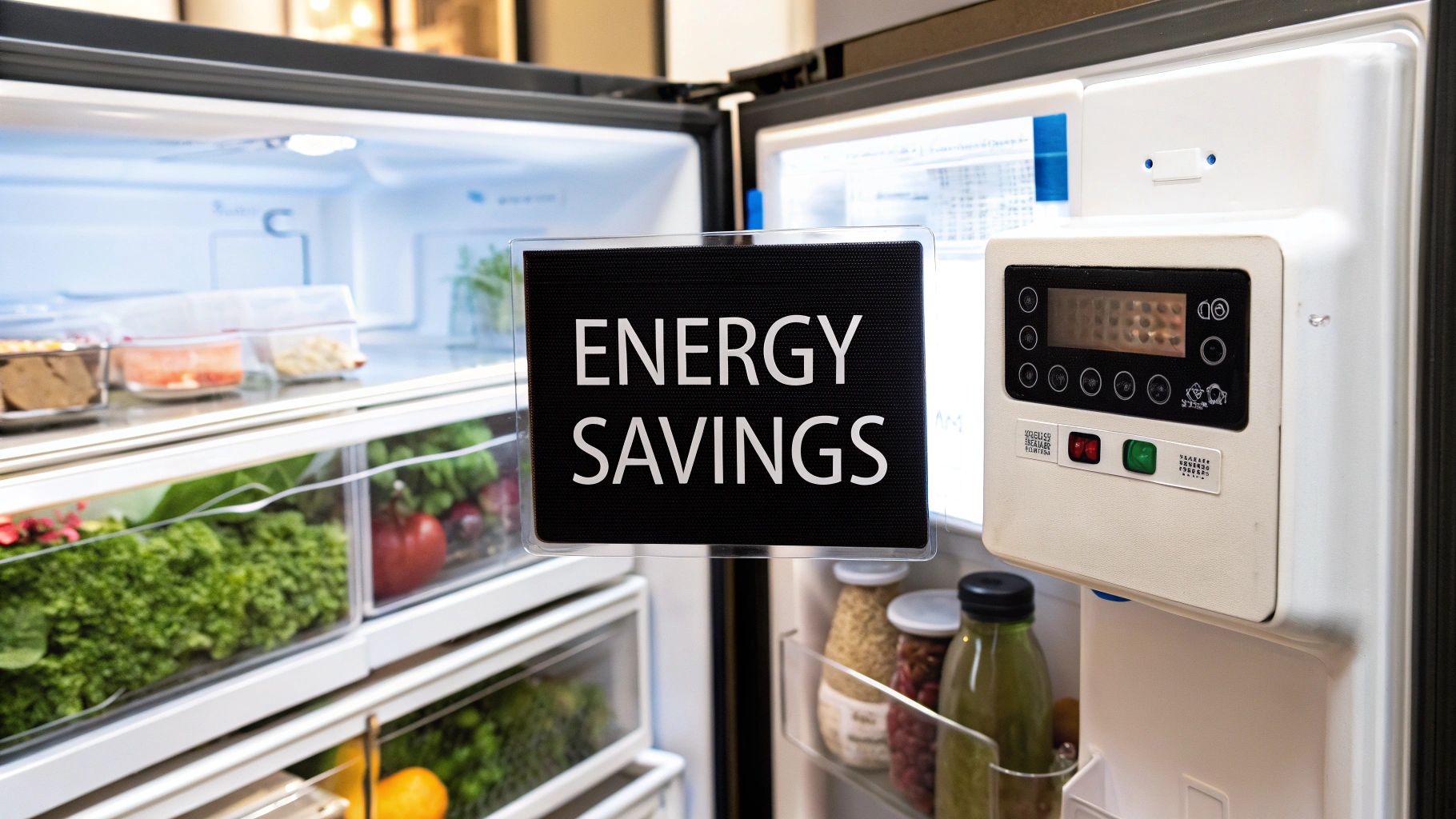
But here’s the thing: these tables aren't a one-size-fits-all deal. They’re engineered for specific jobs. Getting to know the different types of stainless steel prep tables available is the key to setting your kitchen up for success.
Sandwich and Salad Prep Tables: The Quick-Service Champs
For delis, cafes, and any spot that cranks out fresh, made-to-order meals, the sandwich and salad prep table is an absolute necessity. Think of it as your own personal assembly line for freshness. The star of the show is the refrigerated rail up top, built to hold a lineup of food pans packed with sliced meats, cheeses, veggies, and dressings.
This layout lets a cook stand in one place and build a complex sandwich or salad in record time. Running alongside the ingredient pans is a full-length cutting board, giving you a dedicated, food-safe surface to work on. Down below, you’ve got refrigerated cabinets or drawers for stashing backup ingredients, keeping your line fully stocked even when you’re slammed.
These tables are defined by a few key features:
- Refrigerated Pan Rails: Keeps all your toppings perfectly chilled and ready to go.
- Integrated Cutting Boards: A seamless workspace right where you need it.
- Lower Refrigerated Storage: Puts backup inventory within easy reach, so you’re not constantly running to the walk-in.
This design is all about boosting ticket times and keeping your food consistent. To see how these units can really change your workflow, you can learn more about commercial refrigerated prep tables and lock in the right model for your business.
Pizza Prep Tables: Built for Dough
At a glance, they might look like their sandwich-making cousins, but pizza prep tables have a few crucial tweaks to handle the unique world of a pizzeria. The biggest difference? The workspace. Pizza prep tables boast a much deeper cutting board—often 19 inches or more—to give you enough real estate for a large pizza skin without dough flopping over the sides.
That extra depth is non-negotiable for stretching dough, spreading sauce, and loading on toppings, whether you're making personal pies or giant family-sized ones.
A pizza prep table is all about providing a massive, chilled workspace that fits the unique flow of making pizza. Every part of it is designed to keep things moving smoothly from the dough to the oven.
You'll also notice the refrigerated rail is often raised on a pizza prep table. It's an ergonomic touch that brings the topping pans closer, meaning less bending and reaching for your crew over a long, busy shift. The refrigeration in these rails is also incredibly robust, built to keep cheese and meats at safe temps even with the lids constantly opening during the dinner rush. And just like sandwich tables, they have refrigerated cabinets underneath for dough boxes, extra cheese, and sauce.
Choosing Between Models
So, which one is for you? Let your menu be your guide. A deli that hardly ever touches pizza dough doesn't need that extra-deep work surface. On the flip side, a pizzeria would feel incredibly cramped on a standard sandwich prep table.
Keep these points in mind:
- Menu Focus: What's your bread and butter? Sandwiches and salads? Pizza? Let that guide your choice.
- Kitchen Space: Break out the tape measure. These units come in all sizes, from small 27-inch models to huge 93-inch tables.
- Ingredient Volume: The number of pans the rail can hold dictates your topping variety. Always plan for your busiest service to make sure you have enough capacity.
At the end of the day, picking the right refrigerated prep table is an investment in speed, safety, and consistency. When you match your equipment to your menu, you create a powerhouse workstation that helps your team deliver amazing food, shift after shift.
Decoding Key Technical Specifications
Okay, you’ve picked a type. Now comes the part that really matters: the tech specs. This is the stuff under the hood that separates a workhorse from a headache. It determines how well your unit performs, how long it lasts, and what it’s going to cost you on your monthly utility bill.
Don't just look at the price tag. Two refrigerators might seem identical, but the internal components make all the difference in a chaotic kitchen. The compressor, capacity, and energy rating are the three legs of the stool—get these right, and you’ve got a reliable piece of equipment that won’t buckle under pressure.
The Heart of the Unit: Compressor Placement
The compressor is literally the heart of your refrigerator, pumping refrigerant through the system to keep things cold. Where this heart is located—either up top or down below—makes a huge difference in performance and how easy it is to clean. The right choice really just depends on your kitchen's environment.
A top-mount compressor is kind of like a chimney. It sits on top of the fridge, pushing hot air up and away. This design is perfect for cooler, cleaner spaces like bakeries or coffee shops where it’s less likely to suck up all the dust, flour, and grease from the floor.
On the other hand, a bottom-mount compressor is more like a furnace in the basement. It’s at the bottom of the unit, pulling in cooler air from near the floor, which actually makes it run more efficiently in a blazing hot cook line. Plus, this placement makes the compressor way easier to get to for cleaning, and it lifts the bottom shelf up to a more comfortable height. No more bending all the way down to grab that container of prep.
- Top-Mount: Best for cooler, less greasy kitchens. Vents heat away from your staff.
- Bottom-Mount: A must for hot kitchens. It's easier to service and more ergonomic for daily use.
Understanding Capacity and Temperature Zones
Capacity is just a fancy word for how much you can cram inside, measured in cubic feet (cu. ft.). It’s tempting to just buy the biggest refrigerator you can fit, but bigger isn't always better. An under-filled unit has to work overtime to stay cold, which just burns through electricity. You want a well-organized fridge that’s just the right size to promote good airflow and efficiency.
Think about how much inventory you turn over in a week, not just how much floor space you have. The goal is to match the refrigerator's size to your kitchen's actual workflow. That's how you nail efficiency and cut down on energy waste.
Some of the larger, more specialized units also offer multiple temperature zones. A dual-temp model, for instance, gives you both a refrigerator and a freezer in a single footprint. These are fantastic space-savers for smaller kitchens that need both but just don't have the room for two separate machines. This gives you the flexibility to store different products at their perfect temperatures in one piece of equipment.
The Long-Term Value of Energy Efficiency
A commercial refrigerator never sleeps—it runs 24/7, making it one of the biggest power hogs in your entire operation. This is where energy efficiency ratings become your best friend. A more efficient model might cost a bit more upfront, but it can literally save you thousands of dollars in electricity costs over its lifetime.
Always look for the ENERGY STAR label. It’s a government-backed seal of approval, meaning the unit meets strict efficiency standards. On average, ENERGY STAR certified commercial refrigerators are 20% more energy-efficient than standard models. They achieve this with things like better insulation, high-performance compressors, and tighter door seals.
The push for this kind of equipment is a huge deal in the industry. The global market for commercial refrigeration hit about USD 44.44 billion, and it's expected to rocket up to nearly USD 79.38 billion by 2034. A big part of that growth is from businesses like yours looking to slash operating costs with more efficient gear. You can read the full analysis on the commercial refrigeration market to see how these trends are shaping the future of kitchen equipment.
Simply put, buying an efficient commercial refrigerator for sale isn't just a green choice—it’s a smart financial move that pays you back every single month.
Understanding Certifications and Proper Sizing
Don't just jump into comparing features and prices when looking for a commercial refrigerator. Before you get too far down the road, we need to talk about two things that can stop a purchase dead in its tracks: health code compliance and making sure the unit actually fits.
Getting these details wrong can mean failed inspections, expensive return shipping fees, or even needing to knock down a wall. Think of this as the groundwork. A little planning now prevents a massive headache later.
The Non-Negotiable Badge of Safety: NSF Certification
If you see an NSF (National Sanitation Foundation) logo on a piece of kitchen equipment, that’s your green light. It’s not just a sticker—it's a guarantee that the refrigerator was built to meet tough public health and safety standards. For any business that serves food, this is non-negotiable.
Health inspectors are trained to look for that NSF mark. It tells them the unit is designed for safe food handling, which includes specific features that stop bacteria from growing.
- Non-Porous Materials: Surfaces are typically stainless steel, which won't soak up food particles or give germs a place to hide.
- Easy-to-Clean Design: You'll find coved (rounded) interior corners and parts you can easily remove. This gets rid of those tight spots where gunk always seems to build up.
- Built to Last: The unit is tough enough for a busy kitchen and engineered to hold a consistent, food-safe temperature, day in and day out.
Trying to save a bit of cash on a non-certified fridge is a bad bet. It puts you at risk for fines, closures, and the nightmare scenario of making a customer sick. Just make NSF certification a mandatory checkbox on your list and move on with peace of mind.
Sizing Your Space The Right Way
Okay, you've found a great NSF-certified model. Now, for the million-dollar question: will it fit? Sizing isn’t just about the refrigerator's dimensions matching an empty spot on your floor plan. You have to think about two things people always forget—ventilation and the delivery path.
Proper sizing is a two-part puzzle. The refrigerator must not only fit in your kitchen but also through every door and hallway to get there. Forgetting the journey can be a costly mistake.
First, your fridge needs to breathe. Commercial refrigerators have a compressor that kicks out a lot of heat. If it doesn’t have enough airflow around it, it will overheat, work way too hard, suck up more electricity, and eventually burn out. A good rule of thumb is to leave at least 2-3 inches of clearance on the back and sides. If it has a top-mounted compressor, you'll need even more space up top.
Second, walk the delivery route. Grab a tape measure and check the height and width of every single doorway, hallway, and tight corner the fridge has to get through. A unit that's just one inch too wide for the kitchen door is a logistical disaster. And always ask for the "crated" or shipping dimensions—they're always bigger than the final product specs. This one simple step can save you from the gut-wrenching moment of a failed delivery.
Maintenance Tips to Maximize Your Investment
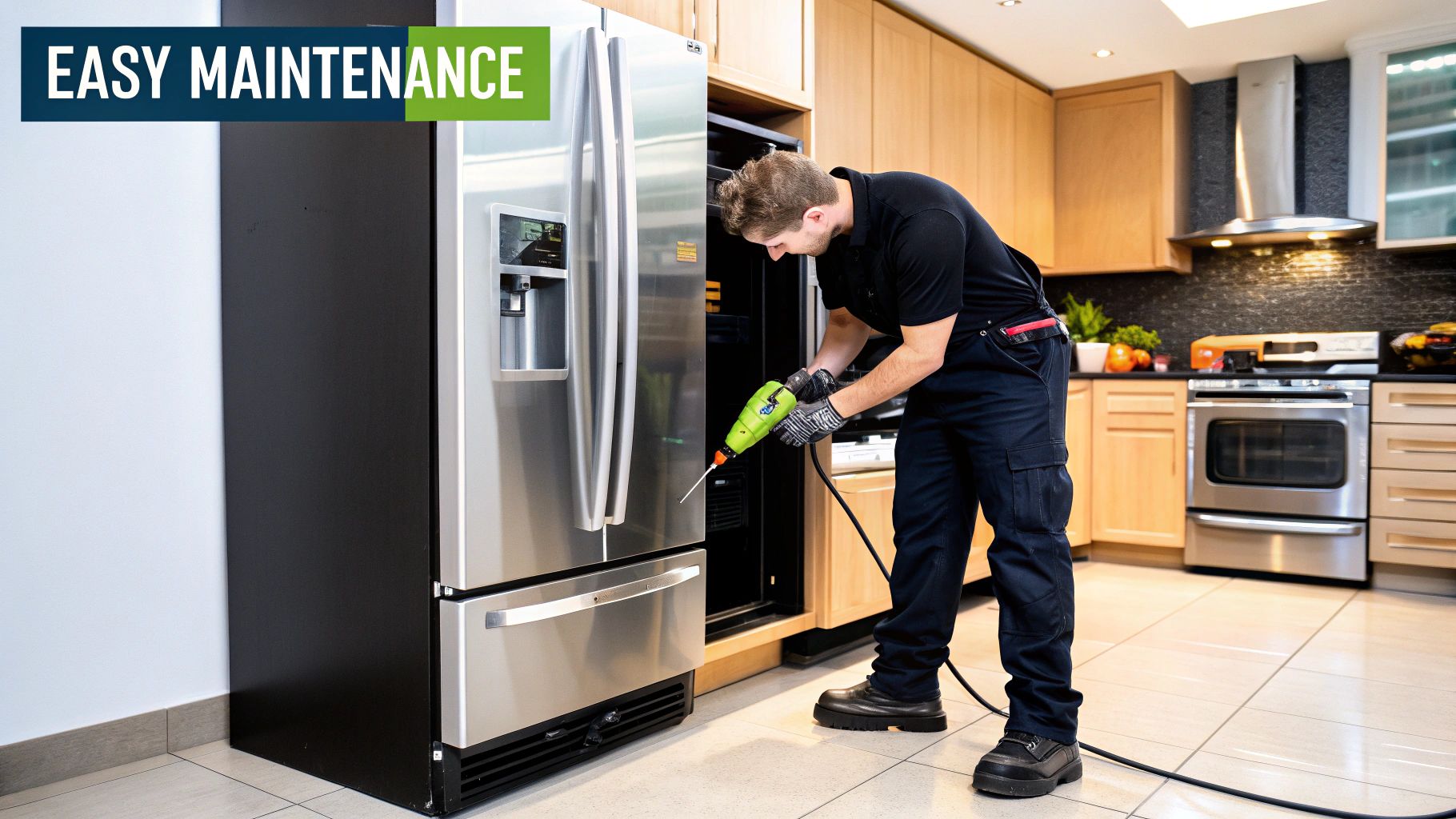
Getting your new commercial refrigerator delivered is just the first step. The real work begins now, and consistent, proper maintenance is the single most important thing you can do to make sure that unit runs efficiently for years to come. This protects both the machine and all the valuable inventory inside it.
Think of it like preventative care for the heart of your kitchen. A little attention now can help you dodge massive, costly emergency repairs down the road. By sticking to a few best practices, you'll cut down on energy use, get more years out of your refrigerator, and keep your food safety standards impeccable.
Routine Cleaning and Upkeep
Your first line of defense is simple, routine stuff. Folding these small checks into your weekly or monthly cleaning schedule is the easiest way to make sure they get done. It doesn't take much time, but the payoff in reliability is huge.
Start with the condenser coils, usually tucked away at the top or bottom of the unit. These coils are basically the radiator for your fridge, pushing heat out of the system. When they get caked with dust, grease, and other gunk, the compressor has to work overtime just to keep things cool. That's a one-way ticket to a higher energy bill and a busted compressor. Just a quick wipe-down or vacuum once a month is all it takes to keep them clear.
A well-maintained refrigerator is more than just a cold box; it's a statement about your commitment to quality and safety. Regular upkeep prevents surprise breakdowns and ensures every ingredient you serve is held at the perfect temperature.
Inspecting Seals and Promoting Airflow
Next up, check out the door gaskets—those flexible rubber seals running along the door's edge. A cracked or worn-out gasket is a major energy-waster. It lets cold air leak out and warm air seep in, forcing your fridge to run constantly just to hold its temperature.
Here’s an easy test: close the door on a dollar bill. If you can slide it out without any resistance, the seal is too weak and the gasket needs to be replaced. It's a cheap and easy fix that will save you a surprising amount of money on electricity.
How you organize your inventory also makes a big difference. If your fridge is packed to the gills, air can't circulate properly, leading to warm spots where food can spoil. Always leave some space between items and away from the walls to let that cold air do its job. It’s a simple habit that ensures everything stays consistently cool. This kind of attention to detail is just as important for other kitchen workhorses; check out our guide on maintaining a commercial ice machine for similar tips.
The global market for commercial refrigeration equipment was valued at USD 49.32 billion and is expected to climb to USD 73.98 billion by 2032. This growth is all about the increasing focus on food freshness and energy efficiency. Retailers are investing big in better systems, which just goes to show how critical this equipment is. You can discover more about the growing commercial refrigeration market and what it means for businesses like yours.
A Few Common Questions Answered
When you're getting close to picking out a commercial refrigerator, a few specific questions always seem to pop up. Let's tackle some of the most common ones to help you lock in your decision with total confidence.
Top-Mount vs. Bottom-Mount Compressor: What’s the Real Difference?
The spot where the compressor lives on your fridge actually makes a big difference in how it runs and how you’ll take care of it.
A top-mount compressor sits, you guessed it, on top of the unit. This is great because it vents hot air up and away from the action on your kitchen floor. If you've got a bakery or a kitchen with a lot of flour and dust flying around, this design is your friend—it's far less likely to suck up all that debris. The only catch? It can be a bit harder to get to for service.
On the flip side, a bottom-mount compressor is tucked away at the base. This setup is a real workhorse on hot cook lines because it pulls in cooler air from near the floor, which helps it run more efficiently when things heat up. It's also way easier to get to for routine cleaning and maintenance, and as a nice bonus, it lifts the bottom shelf up to a more back-friendly height.
Why Is NSF Certification Such a Big Deal?
Think of NSF (National Sanitation Foundation) certification as a non-negotiable seal of approval for any gear you bring into a professional kitchen. It's your guarantee that the refrigerator was designed from the ground up with public health and food safety as the top priority.
An NSF-certified refrigerator isn't just a suggestion; it's a requirement for passing most local health inspections. It means the unit meets tough standards for materials, design, and performance, ensuring it’s a breeze to clean and won't become a breeding ground for bacteria.
Here’s what that certification really means:
- Safe Materials: The entire unit is built from non-toxic, corrosion-resistant stuff that will never contaminate your food.
- Hygienic Design: It’s all smooth surfaces and coved corners. There are no nooks or crannies where gunk and bacteria can hide out.
- Proven Performance: The fridge has been put through its paces to prove it can hold consistent, safe temperatures, even in the chaos of a busy kitchen.
Should I Go for a New or Used Commercial Refrigerator?
That low price tag on a used commercial refrigerator can be really tempting, but it almost always comes with a bundle of risks. Used units rarely have a warranty, you have no idea what their service history looks like, and they’re often energy hogs that will drive up your utility bills. You could easily be facing surprise repair costs much sooner than you think.
Buying a new unit, however, is an investment in peace of mind. It comes straight from the factory with a full manufacturer's warranty, is packed with modern energy-saving tech, and you know it complies with all the latest health and safety codes. When you're talking about a critical piece of equipment that runs 24/7, the reliability and efficiency you get with a new refrigerator is almost always worth more than the upfront cash you’d save on a used one.
At PrepTables.com, we stock durable, high-performance commercial refrigeration built to handle the daily grind of any professional kitchen. Take a look at our huge collection of NSF-certified refrigerators, freezers, and prep tables to find the perfect gear for your business at https://preptables.com.
